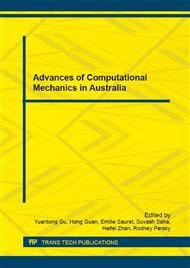[1]
ABAQUS, Standard User's Manual. Version 6. 12, ABAQUS, Inc., Rising Sun Mills, (2014).
Google Scholar
[2]
LSTC (Livermore Software Technology Corporation), LS-DYNA Keyword User's Manual, CA, USA, (2003).
Google Scholar
[3]
T.L. Teng, Y. Chu, F. Chang, B.C. Shen, D.S. Cheng, Development and validation of numerical model of steel fibre reinforced concrete for high-velocity impact, Computational Materials Science 42 (2008) 90-99.
DOI: 10.1016/j.commatsci.2007.06.013
Google Scholar
[4]
Z.L. Wang, J. Wu, J.G. Wang, Experimental and numberical analysis on effect of fibre aspect ratio on mechanical properties of SFRC, Construction and Building Materials 24 (2010) 559-565.
DOI: 10.1016/j.conbuildmat.2009.09.009
Google Scholar
[5]
G. Campione, M.L. Mangiavillano, Fibrous reinforced concrete beams in flexure: experimental investigation, analytical modelling and design considerations, Engineering Sturctures 30 (2008) 2970-2980.
DOI: 10.1016/j.engstruct.2008.04.019
Google Scholar
[6]
K. Murugappan, K.H. Tan, P. Paramasivam, Finite element formulation for the analysis of reinfored fibrous concrete beams, Finite Elements Analysis and Design 18 (1994), 67-74.
DOI: 10.1016/0168-874x(94)90091-4
Google Scholar
[7]
D.M. Ozcan, A. Bayraktar, A. Sahin, T. Haktanir, T. Turker, Experimental and finite element analysis on the steel fiber-reinforced concrete (SFRC) beams ultimate behaviour, Construction Building Materials 23 (2009) 1064-1077.
DOI: 10.1016/j.conbuildmat.2008.05.010
Google Scholar
[8]
S. Swaddiwudhipong, P.E.C. Seow, Modeling of steel fiber-reinforced concrete under multi-axial loads, Cement and Concrete Research 36 (2006) 1354-1361.
DOI: 10.1016/j.cemconres.2006.03.008
Google Scholar
[9]
A. Beghini, Z.P. Bazant, Y. Zhou, O. Gouirand, F.C. Caner, Microplane model M5f for multiaxial behaviour and fracture of fibre-reinforced concrete, Journal of Engineering Mechanics 133 (2007) 66-75.
DOI: 10.1061/(asce)0733-9399(2007)133:1(66)
Google Scholar
[10]
D. Fanella, D. Krajcinovic, Continuum damage mechanics of fiber reinforced concrete, Journal of Engineering Mechanics 111 (1985) 995-1009.
DOI: 10.1061/(asce)0733-9399(1985)111:8(995)
Google Scholar
[11]
X. Peng, C. Meyer, A continuum damage mechanics model for concrete reinforced with randomly distributed short fibres, Computers and Structure 78 (2000) 505-515.
DOI: 10.1016/s0045-7949(00)00045-6
Google Scholar
[12]
Jr.J.E. Bolander, S. Saito, Discrete modeling of short-fiber reinforcement in cementitious composites, Advanced Cement Based Materials 6 (1997) 76-86.
DOI: 10.1016/s1065-7355(97)90014-6
Google Scholar
[13]
Z. Li, M.A. Perez Lara, J.E. Bolander, Restraining effect of fibers during non-uniform drying of cement composites, Cement and Concrete Research 36 (2006) 1643-1652.
DOI: 10.1016/j.cemconres.2006.04.001
Google Scholar
[14]
E. Schlangen, J.G.M. van Mier, Simple latice model for numerical simulation of fracture of concrete materials and structures, Materials and Structures 25 (1992) 534-542.
DOI: 10.1007/bf02472449
Google Scholar
[15]
P. Kabele, Multiscale framework for modeling of fracture in high performance fiber reinforced cementitious composites, Engineering Fracture Mechanics 74 (2007) 194-209.
DOI: 10.1016/j.engfracmech.2006.01.020
Google Scholar
[16]
E. Guillermo, A. Caggiano, S. Vrech, Multiscale failure analysis of fiber reinforced concrete based on a discrete crack model, International Journal of Fracture 178 (2012) 131-146.
DOI: 10.1007/s10704-012-9733-z
Google Scholar
[17]
H. Thomas, H. Andrea, R. Ekkehard, Modeling of failure in composites by X-FEM and level sets within a multiscale framework, Computer Methods in Applied Mechanics and Engineering 197 (2008) 414-424.
DOI: 10.1016/j.cma.2007.07.017
Google Scholar
[18]
H. Tian, Y.X. Zhang, L. Ye, C.H. Yang, Mechanical behaviours of green hybrid fibre-reinforced cementitious composites, Construction and Building Materials 95 (2015) 152-163.
DOI: 10.1016/j.conbuildmat.2015.07.143
Google Scholar
[19]
H. Tian, Mechanical behavior of high volume fly ash cementitious composites reinforced with hybrid natural and steel fibres, The University of New South Wales, PhD thesis, (2015).
Google Scholar


